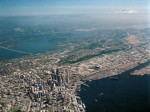Funding: NSF
The overarching goals of our biocomplexity research are to explore the mechanisms and model the interactions that link socioeconomic forces and the functioning of terrestrial ecosystems in urbanizing environments. Urbanizing ecosystems are emergent phenomena that evolve over time and space as the outcome of dynamic interactions between socio-economic and biophysical processes operating simultaneously over multiple spatial and temporal scales. Individual choices and actions affect ecosystem processes and ecological conditions, which in turn affect human decisions. Understanding the dynamics of urbanizing ecosystems thus requires an integrated framework that simultaneously considers the reciprocal interactions between human and biophysical patterns, processes, and functions. Our research on coupled human-natural systems, funded through the National Science Foundation‘s Biocomplexity Program, examines the dynamics of urban ecosystems to test hypotheses about how human-dominated ecosystems evolve through these complex interactions.
Projects:
Biocomplexity I: Modeling the Interactions Among Urban Development, Land Cover Change, and Bird Diversity. Marina Alberti (PI), Paul Waddell, John Marzluff, & Mark Handcock
Biocomplexity II: Urban Landscape Patterns: Complex Dynamics and Emergent Properties. PIs: Marina Alberti (PI), John Marzluff, Mark Handcock, Charles Redman, Jianguo Wu, J. Marty Anderies, Dieter Fox, Henry Kautz, & Paul Waddell
